
Choristoneura rosaceana, the oblique banded leaf roller or rosaceous leaf roller, is a moth of the family Tortricidae. It is native to North America, but has been accidentally introduced into other parts of the world.
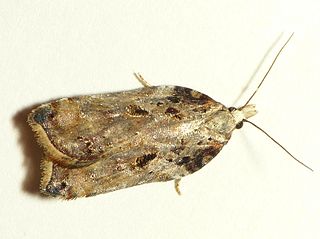
Acleris cristana, the rufous-margined button moth, is a moth of the family Tortricidae and is found from Europe through the Caucasus and Ussuri to Japan.
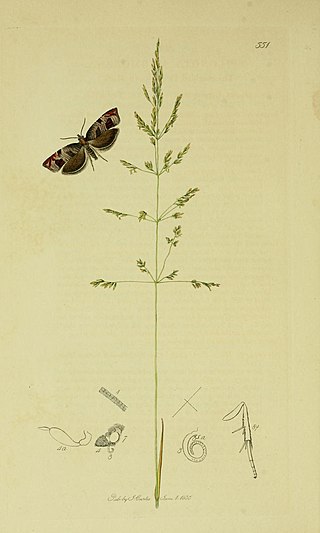
Acleris maccana, the marbled dog's-tooth tortrix, is a moth of the family Tortricidae. The species was first described by Georg Friedrich Treitschke in 1835. It is found from Europe, east across the boreal regions to Siberia.

Acleris laterana is a moth of the family Tortricidae. It is native to the Palearctic realm, but has been accidentally imported into the United States.

Pandemis cinnamomeana is a moth of the family Tortricidae. It is found from Europe to Russia, China, Korea and Japan.
Archips asiaticus, the groundnut leafroller, is a species of moth of the family Tortricidae. It is found in Russia (Siberia), Korea, Japan and China.
Archips fuscocupreanus, the exotic leafroller moth or apple tortrix, is a species of moth of the family Tortricidae. It is found in China, South Korea, Japan and Russia. It is an introduced species in the north-eastern United States, where it has been recorded from Connecticut, Massachusetts, New Jersey, New York and Rhode Island. It has also been recorded from Washington.
Spilonota albicana, the white fruit moth, larger apple fruit moth or eye-spotted bud moth, is a species of moth of the family Tortricidae. It is found in China, Korea, Japan and Russia. It has been accidentally introduced in the Netherlands.
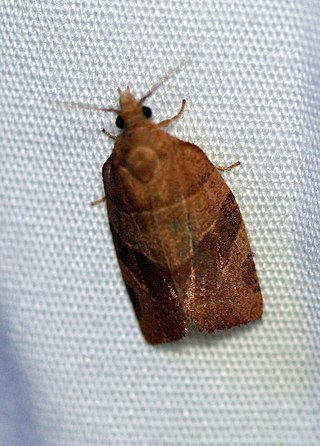
Pandemis limitata, the three-lined leafroller, is a species of moth of the family Tortricidae. It is found in North America, where it has been recorded from Nova Scotia to British Columbia and from the east coast west to the Rocky Mountains and Arizona. It has also been recorded from Durango in Mexico.
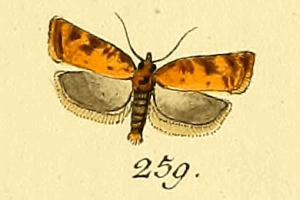
Acleris aspersana, the ginger button, is a species of moth of the family Tortricidae. It is found in Europe, where it has been recorded from Ireland, Great Britain, France, the Benelux, Germany, Denmark, Austria, Switzerland, Italy, the Czech Republic, Slovakia, Slovenia, Croatia, Hungary, Bulgaria, Romania, Poland, Norway, Sweden, Finland, the Baltic region and Russia. It is also found in the Near East and the eastern Palearctic realm. Their habitat consists of meadows and forest edges.

Acleris fimbriana, the yellow tortrix moth, is a species of moth of the family Tortricidae. It is found in France, Germany, Denmark, Italy, Slovakia, Hungary, Romania, Poland, Norway, Sweden, Finland, the Baltic region, Ukraine and Russia. It is also found in China and South Korea.

Acleris lipsiana is a species of moth of the family Tortricidae. It is found in Great Britain, Spain, France, Belgium, the Netherlands, Germany, Denmark, Austria, Switzerland, Italy, the Czech Republic, Slovakia, Hungary, Poland, Greece, Norway, Sweden, Finland, the Baltic region and Russia. It is also found in North America, where it has been recorded from Alberta and Washington. The habitat consists of high moors and mountainous areas.

Acleris umbrana is a species of moth of the family Tortricidae. It is found in Great Britain, France, Belgium, Germany, Austria, Switzerland, Italy, the Czech Republic, Slovakia, Poland, Hungary, Norway, Sweden, Finland, the Baltic region and Russia. In the east, the range extends to Japan. The habitat consists of woodland, fens and marshes.
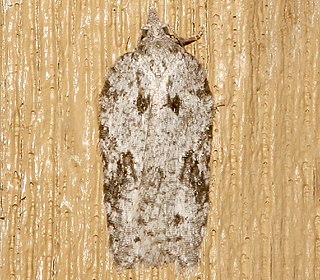
Acleris maximana is a species of moth of the family Tortricidae first described by William Barnes and August Busck in 1920. It is found in North America, where it has been recorded from Alberta, British Columbia, California, Maryland, Massachusetts, Michigan, Montana, New Brunswick, North Carolina, Ontario, Pennsylvania, Saskatchewan, Tennessee, Utah and Washington.

Acleris chalybeana, the lesser maple leafroller moth, is a species of moth of the family Tortricidae. It is found in North America, where it has been recorded from Arkansas, Connecticut, Florida, Illinois, Indiana, Kentucky, Maine, Maryland, Mississippi, New Hampshire, New Jersey, New York, North Carolina, Ohio, Ontario, Pennsylvania, Quebec, South Carolina, Tennessee, West Virginia and Wisconsin.
Acleris flavivittana, the multiform leafroller moth, is a species of moth of the family Tortricidae. It is found in North America, where it has been recorded from Georgia, Illinois, Indiana, Kentucky, Maine, Maryland, Massachusetts, Michigan, New Brunswick, New Hampshire, New Jersey, New York, North Carolina, Ohio, Ontario, Pennsylvania, Quebec, Tennessee, Vermont, Virginia, Washington, West Virginia and Wisconsin.
Acleris minuta, the yellow-headed fireworm or lesser apple leaf-folder, is a species of moth of the family Tortricidae. It is found in eastern North America.
Acleris indignana is a species of moth of the family Tortricidae. It is found in the Russian Far East (Ussuri) and Japan.
Acleris extensana is a species of moth of the family Tortricidae first described by Francis Walker in 1863. It is found in Sri Lanka, India, China and Vietnam.
Acleris paradiseana is a species of moth of the family Tortricidae. It is found in the Russian Far East and Japan.












